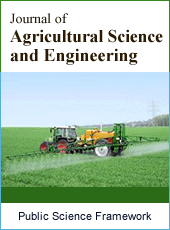Journal of Agricultural Science and Engineering
Articles Information
Journal of Agricultural Science and Engineering, Vol.7, No.2, Jun. 2021, Pub. Date: Jun. 28, 2021
Development of Surface Spate Irrigation System Capable to Irrigate a Large-Scale Area at the Lowest Cost
Pages: 23-29 Views: 1785 Downloads: 282
[01]
Hassan Elhaj Hamed Alsayim, Department of Agricultural Engineering, Faculty of Agriculture, Nile Valley University, Darmali, Sudan.
[02]
Aboubaker Ahmed Osman, Department of Civil Engineering, Faculty of Engineering & Technology, Nile Valley University, Atbara, Sudan.
[03]
Salah Ahmed Ali, Department of Civil Engineering, Faculty of Engineering & Technology, Nile Valley University, Atbara, Sudan.
Irrigated area in River Nile state faces many difficulties. The most difficult is the need of large quantity of energy to operate. Surface irrigation is the least energy consuming irrigation scheme but it requires a high cost infra-structure (dams and storage facilities). Atbara River has natural steeply slope, in some places more than 75 cm/km. This steeply slope made it perfect for developing irrigation system, a mix of spate and surface irrigation. The developed irrigation system is expected to be less expensive than surface irrigation and more effective than spate irrigation. This paper aims to investigate the possibility of irrigating 630,000 hectares on the left bank of Atbara River using surface spate irrigation system. The hydrology of the Atbara River was studied and suitable cropping pattern were chosen accordingly. The terrain analysis was carried out for planning the irrigation and drainage canals with minimum construction cost. The total area was divided into three sub zones according to the topography surveys of the area. Software programs were used and Excel templates were created to vacillate the interdependent design parameters. Five types of soil were identified and mapped are: sand dune; thin wavy layer of sand over a flat clay soils; flat desert lands; cracked dark-colored clay soils and the “vertesol” lowlands. The arable land was estimated to be 445,200 hectares represent 70% of the total area. The maximum water requirement of the crops ranged from 6.75 to 8.98 mm/day. The total discharge for the three main canals is about 607 m3/s. The required discharge to meet the maximum needs was estimated at 1012 million m3/month (33.7 million m3/day) with an average of 14 working hours per day and the total discharge required is about 670 m3/s (increased by 10% as transfer losses). The irrigation canal system was designed, the total length of the canals is 3,426 km and the total irrigated areas is 419,605 hectares. The total volume of the excavation and filling (transferred) works is about 34,686,189 m3 and 121,983,197 m3, respectively. The paper concluded that more than 90% of the suitable agricultural area can be irrigated using surface spate irrigation system with lowest energy consumption.
Surface, Spate Irrigation, Atbara River Hydrology, Tekzi Dam, Planning, Canals Design
[01]
United Nations (UN) (2020): Population. United Nations, Available at: https://blogs.worldbank.org/opendata/chart-globally-70-freshwater-used-agriculture. Accessed on 30 March 2021.
[02]
World Bank (2017): Globally, 70% of Freshwater is used for Agriculture, World Bank, Available at: https://blogs.worldbank.org/opendata/chart-globally-70-freshwater-used-agriculture. Accessed on 20 April 2021.
[03]
World Bank. (2019): The World Bank Data, GDP Growth (annual %) (Available at: https://data.worldbank.org/indicator/NY.GDP.MKTP.KD.ZG).
[04]
Ministry of Production and Economic Resources (2015): Land Use Study of River Atbara Area. Nile Valley University Consultancies Corp.
[05]
FAO (2020): The Sudan 2020 Flood impact rapid assessment September 2020. A joint assessment with the Government of the Sudan. Food and Agriculture Organization of the United Nations Rome, 2020.
[06]
Gellings C. W. (2009): Efficient use and conservation of energy. Vol. II. Eolss Publishers, Oxford, United Kingdom.
[07]
Hoff, H. (2011): Understanding the Nexus. In Background Paper in: Bonn 2011 Conference the Water, Energy and Food Security Nexus, Solutions for the Green Economy; Stockholm Environment Institute: Stockholm, Sweden.
[08]
United Nations World Water Assessment Programme (WWAP). (2014): The United Nations World Water Development Report 2014: Water and Energy; UNESCO: Paris, France, 2014.
[09]
IEA. (2016): International Energy Agency: Paris, France.
[10]
OECD. (2012): OECD Environmental Outlook to 2050; Organization for Economic Co-operation and Development: Paris, France.
[11]
Allen, R. G., Pereira, L. S. Raes, D. and Smith. M. (1998): Crop evapotranspiration, guidelines for computing crop water requirements, FAO Irrig, and Drain. Paper 56, Food and Agric. Orgn of the United Nations, Rome, Italy. 300 pp.
[12]
Chow V. T. (1983): Open Channel Hydraulics, McGraw Hill Classic Textbook Series.
[13]
United States Department of Agriculture (USDA) Soil Survey Staff. (1999): Soil taxonomy, a basic system of soil classification for making and interpreting soil surveys. 2nd edition. Agricultural Handbook No. 436. Washington, DC. 869 pp.
[14]
Alsayim H. E. (2021): Technical Performance Evaluation of Center Pivot Sprinkler Irrigation Systems in the Atbara River Region, Sudan. Journal of Agricultural Science and Engineering. Vol. 7, No. 1, pp. 1-7.

ISSN Print: 2381-6821
ISSN Online: 2381-6848
Current Issue:
Vol. 7, Issue 4, December Submit a Manuscript Join Editorial Board Join Reviewer Team
ISSN Online: 2381-6848
Current Issue:
Vol. 7, Issue 4, December Submit a Manuscript Join Editorial Board Join Reviewer Team
| About This Journal |
| All Issues |
| Open Access |
| Indexing |
| Payment Information |
| Author Guidelines |
| Review Process |
| Publication Ethics |
| Editorial Board |
| Peer Reviewers |


